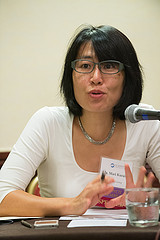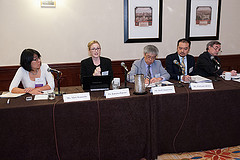Japan’s Civil Sector in Perspective
“Japan’s Civil Sector in Perspective” was one of ten panel discussions that was held on October 4, 2013, during the 4th USJC Annual Conference.
Panelists
Moderator: Ms. Mari Kuraishi, Co-founder & President, GlobalGiving
Speakers: Dr. Ramona Bajema, Country Representative, Japan, AmeriCares
Mr. Eiichi Sadamatsu, Former Trustee, JANIC & Deputy Secretary-General, Save the Children Japan
Mr. Noriyuki Shiina, Secretary General, Japan Platform
Dr. Steven Rathgeb Smith, Executive Director, American Political Science Association
Description
Japan’s civil sector played an indispensable role in mobilizing a response to the 2011 Tohoku disaster. Civil society insiders hoped that as the Kobe earthquake jumpstarted volunteerism in Japan, the Tohoku disaster might trigger a professionalization and stronger fundraising capacity among NGOs in Japan. Two years later, where does the Japanese civil sector stand? Does Japan have the civil sector it needs? How does it compare to and what might it leverage from civil society in other nations? What are its particular challenges and opportunities? Considering these questions, this session examined the historical and contemporary contexts and provide a comparative analysis.
Summary
Special thanks to moderator Mari Kuraishi for providing this summary!
There is no doubt that the Japanese nonprofit sector has played a prominent role in the recovery from the East Japan earthquake and tsunami in 2011. The panelists discussed many positive changes that the sector experienced, as well as the challenges they must overcome in order for the sector to continue to grow.
Before 2011, Japanese nonprofit organizations were divided into two groups: one focusing on international development, the other focusing on local needs. The internationally focused NGOs were larger, more professionalized, and accustomed to presenting their work in the context of solving systemic issues, programs and projects adhering to clear budgets, and accustomed to consistent reporting. The locally focused NGOs were more diverse, much smaller on average, and more often than not reliant on volunteer labor. These two groups had little reason in the past to collaborate or communicate with each other. However, after the earthquake, as international aid flowed into Tohoku, these two groups learned how to collaborate and provide services in the most needed areas efficiently. A key question for the future of the sector includes how this collaboration can be leveraged, continued, and expanded—as the INGOs will inevitably face pressures to turn their attention back to the global scene.
The huge waves of volunteers wanting to help Tohoku after March 11th presented another opportunity for the nonprofit sector. Many corporate workers took leave from work to volunteer. Groups of college students also organized themselves to volunteer all over Tohoku. The question, widely applicable to other situations, is how to engage volunteers long-term. As the characteristics of those who volunteer become more diverse, it is important to engage the volunteers in a way that they feel that they have contributed to the cause permanently, rather than for a temporal period.
The Japanese nonprofit sector still faces many challenges as it continues to grow. Public recognition of the profession continues to be low, and many nonprofits are forced to scale down their projects due to the lack of capacity and funding. Japanese nonprofits need to strengthen policy advocacy in order to change the environment. This hopefully will include a change in tax incentives for donations to charity.
During the Q&A session, the question “What can JET participants do to help in the face of a natural disaster?” sparked a discussion. A panelist from an international organization suggested that JET participants who have more local knowledge can direct the organization to local nonprofits that need help. Another participant suggested that JET participants can help local organizations that want global exposure and fundraising through their English capabilities.
In the future, the Japanese nonprofit sector will continue to play an important role in Japanese disaster relief, and should use the expertise gained from 3.11 to assist aid workers internationally. A key recommendation from the working group of nonprofits was to integrate the accidents at nuclear generation facilities into the potential range of disasters faced by particular communities, so that targeted mitigation strategies can be in place. Further, the government, private sector and nonprofit sector of Japan should work together to build a disaster risk reduction framework in preparation for the next, inevitable, disaster.


